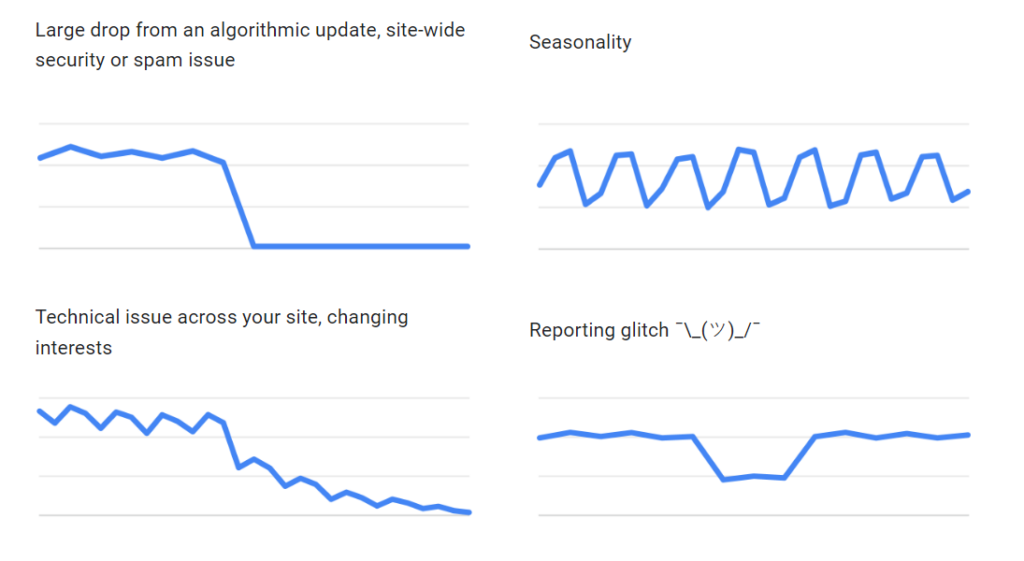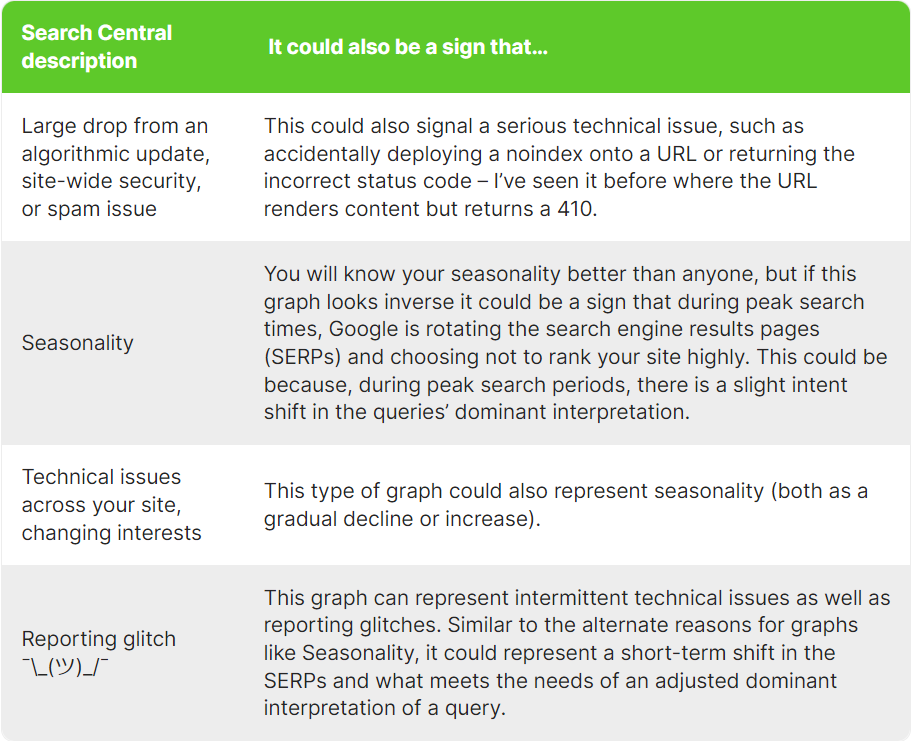

Last updated on

Google Search Console serves as a vital tool providing crucial insights into how your website performs in Google search results.
At times, you may notice a sudden decrease in organic traffic, making it essential to pinpoint the reasons behind this decline. Google Search Console (GSC) stores valuable data that can be pivotal in diagnosing and comprehending changes affecting your website.
Before diving into troubleshooting traffic drops in GSC, it’s crucial to grasp Google’s guidelines on interpreting traffic graphs and its reporting of various metrics.
Google provides fairly comprehensive documentation on debugging drops in search traffic, which can help mitigate immediate panic over data changes. However, despite this resource, Search Console data often remains misunderstood by clients and newcomers to SEO.

Even with these explanations, if your graphs of clicks and impressions start to resemble any of the examples above, they may indicate broader implications.

Google uses a combination of technical methods and policies to filter Click and Impression data in Google Search Console, ensuring accuracy, reliability, and integrity. These efforts address several reasons:
One significant factor influencing fluctuations in reported numbers via the UI and API is the use of thresholds. Google sets these thresholds to determine when to include data in reports. This practice helps maintain statistical reliability by excluding data from queries or impressions that occur very infrequently. For instance, queries with minimal impressions may be omitted to prevent skewing metrics and ensure the accuracy of reported data.
Google Search Console calculates the Average Position metric by averaging the rankings of a website’s URLs for a particular query or set of queries over a defined period.
Whenever a URL appears in search results for a query, its position is recorded separately for each occurrence. For example, if a URL ranks 3rd for one query and 7th for another, these positions are logged individually.
With the emergence of AI Overviews, John Mueller confirmed in Slack conversations that appearing in a generated snapshot affects how the average position of a query and/or URL is displayed in the Search Console UI.

While I don’t use the average position metric in GSC for rank tracking, it can be valuable for diagnosing whether Google is struggling to establish a dominant page for specific queries.
Understanding how the tool aggregates data enables better troubleshooting, linking it to events like Google updates or site developments.
A Google broad core algorithm update represents a substantial revision to Google’s search algorithm aimed at enhancing the relevance and quality of search results.
These updates are not directed at particular sites or content types but instead modify fundamental systems that form the algorithm’s “core,” often prompting Google to publicly announce their occurrence.
Google routinely updates its numerous systems, so even without an official announcement, a change in traffic can still be attributed to a Google update.
For instance, the website depicted in the screenshot experienced a drop in traffic following the March 2023 core update but subsequently recovered during the November 2023 core update.

Another screenshot illustrates another instance where traffic declined in conjunction with a Google update, highlighting that not all sites recover with subsequent updates.

This particular site primarily features informational content complemented by a few marketing landing pages, following a typical SaaS model. Its traffic has shown a consistent decline, notably coinciding with the September 2023 update focused on enhancing helpful content.
Websites that experience negative impacts from a broad core update cannot typically resolve specific issues to regain lost traffic.
Instead, webmasters should prioritize delivering high-quality content and enhancing overall site quality.
Recovery might occur with the next broad core update if the site has significantly improved its quality and relevance, or if Google adjusts its systems and signal weightings to favor the site again.
In SEO terminology, these fluctuations in traffic are often referred to as algorithmic penalties, which may require a considerable amount of time to recover from.
With the introduction of AI Overviews, I anticipate many SEO professionals will engage in this type of analysis in the coming months.
Furthermore, alongside AI Overviews, Google can opt to incorporate various SERP features, such as:
These features not only divert user attention away from traditional organic results but also contribute to pixel shifts.
Based on our SGE/AI Overviews testing, we have observed traditional results being pushed down approximately 1,000 to 1,500 pixels.
When this occurs, third-party rank tracking tools may not indicate a decrease, but you will observe a decline in clicks within Google Search Console (GSC).
The influence of SERP features on your traffic hinges on two factors:
Typically, SERP features have a more pronounced effect on mobile traffic due to their significant impact on scroll depth, especially given the smaller screen size.
To determine your primary traffic source, examine the device breakdown provided in Google Search Console.

You can then compare both graphs directly in the user interface (UI) or export data via the API, where it’s segmented by devices for detailed analysis.
When Google rolls out new SERP features, you can adapt your content and site to enhance eligibility for them.
These features may be influenced by structured data or determined by Google systems analyzing your content.
If a new Google feature leads to an increase in zero-click searches for specific queries, start by measuring the traffic impact. Then, adjust your strategy to improve visibility for related queries that remain crucial in your audience’s search journey.
Seasonality in demand refers to the predictable fluctuations in consumer interest and purchasing behavior that occur during specific times of the year. These fluctuations are influenced by factors such as holidays, weather changes, and cultural events.
For many ecommerce businesses, peaks in demand typically occur leading up to Christmas and Thanksgiving. In contrast, travel companies experience seasonality peaks at different times of the year, depending on the destinations and types of vacations they offer.
The screenshot below exemplifies the typical pattern of a business experiencing a seasonal peak in the lead-up to Christmas.

You can observe these trends in the Performance Report section and usually find similar user and session patterns mirrored in other analytics platforms.
During a seasonal peak, Google may adjust the search engine results pages (SERPs) by reevaluating which websites are ranked and which SERP features are displayed. This adjustment occurs because the surge in search demand often shifts user intent, thereby influencing how Google interprets the query.
In the travel sector, this shift commonly transitions from a research-oriented intent to a commercial intent. During off-peak seasons, searchers typically research destinations or seek deals. However, when peak booking periods arrive, they use the same search queries but with the intention to make bookings.
Consequently, webpages that emphasize informational content may be “demoted” in rankings or replaced by pages that Google perceives as better fulfilling the commercial intent of users. This adjustment reflects Google’s efforts to prioritize webpages that align closely with the evolving search intent during seasonal peaks.
Dealing with fluctuations in traffic due to seasonal changes isn’t straightforward to fix directly.
Nevertheless, you can adapt your SEO strategy to address this challenge. By focusing on creating content that caters to the needs and intentions of users who are in the research and information-gathering phase, you can enhance visibility for your website during non-peak periods. This approach allows you to better manage the effects of seasonal variations on your traffic.
A Google penalty refers to a punitive measure imposed by Google on a website, resulting in a decrease in search rankings or even removal from search results. Such penalties usually stem from violations of Google’s guidelines.
In addition to receiving a notification in Google Search Console (GSC), you’ll likely observe a significant drop in traffic, resembling the graph below:

The severity of the penalty—whether it affects specific parts of your site or the entire site—depends on the extent of the traffic decline. The type or reason for the penalty determines the necessary actions for recovery and the time it will take to regain lost rankings.
A common challenge I often encounter when working with organizations is the misunderstanding that changes to a PPC (Pay-Per-Click) campaign can impact organic traffic as well.
For instance, consider the impact on brand-related searches. When a paid search campaign for your brand is launched, it often leads to a decrease in organic clicks and click-through rates (CTRs). This is typically because many organizations manage SEO and PPC separately, which can result in a lack of communication regarding these potential effects.
You can use the Search results performance report in Google Search Console (GSC) to identify whether there’s cannibalization between your SEO and PPC efforts. This report allows you to correlate drops in branded and non-branded traffic with the changelog from those responsible for managing the PPC campaign. Understanding these correlations can help mitigate unintended consequences and align your strategies more effectively.
Ensuring all stakeholders grasp the reasons behind changes in organic traffic, and preventing loss of traffic (and users), involves attributing it to Paid traffic now.
Determining if this decision is optimal necessitates discussing with PPC campaign managers. If they deliver strong Return on Ad Spend (ROAS), acknowledging and accepting the loss of organic traffic becomes crucial.
Recovering from Google updates can be a lengthy process.
Recently, John Mueller emphasized that sometimes, recovery hinges on waiting for the next update cycle.
However, this doesn’t imply passivity; actively improving your website to better align with Google’s criteria and adapting to potential reversals in signal weighting changes are essential.
It’s crucial to start implementing corrective measures promptly. The sooner you address issues and enhance your site, the sooner you can initiate the path to recovery. The duration of recovery varies based on the underlying causes of the decline, often involving multiple factors. Ultimately, focusing on building a superior website that enhances user experience and service remains paramount.
Original news from SearchEngineJournal